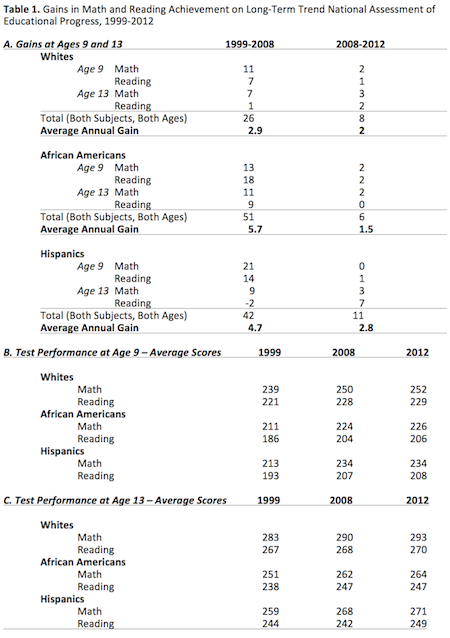As I point out in , the mainstream media have paid scant attention to the latest trends in student achievement up through 2012 just provided by the National Assessment of Educational Progress (NAEP). The silence is deafening, as the results provide us with an initial report card on the Obama Administration”s education policies.
Since NAEP’s long-term trend survey is administered only episodically, we don’t have year- by-year changes in student performance for the Obama years. But NAEP does provide a common measuring stick that allows us to identify what has happened between three key points in time:
1999 – when state and national accountability systems were beginning to be put into place and Clinton and Bush were both giving the idea their bipartisan support, including the passage of No Child Left Behind (NCLB);
2008 – the last year of a gasping Bush Administration, when opponents of NCLB were gaining the upper hand;
and, now, with its latest release,
2012 – when an anti-NCLB administration has been in power for several years
Though analysts don’t always appreciate the fact, the Obama Administration has had a sharp, clear, strong education policy. While most steps have been taken by executive action, its innovations are no less dramatic for that reason. Its anti-NCLB focus dates to the period when candidate Obama, together with congressional Democrats and teacher union leaders, used the bully pulpit provided by the election campaign to relentlessly attack NCLB’s accountability provisions. After coming into office, the Administration, as part of its stimulus package, dropped billions of additional dollars into local school district coffers while administratively gutting NCLB. A new approach was activated via Race to the Top and via waiver policies that have allowed 40 states to substitute the rules set forth by the Obama team in lieu of any remaining NCLB requirements.
All those steps would be praiseworthy if they had corrected an NCLB disaster that added to the white-black test score gap and failed to open the educational door to the Hispanic community. If that is what the latest NAEP data had shown, the credit would go to Secretary Arne Duncan and his boss in the White House.
But the latest NAEP results show quite the opposite. As I discuss in the Wall Street Journal and display more fully in the table below, student achievement, after rising steadily during the 1999-2008 period, has come to a virtual halt during the time the Obama Administration has held the reins of power. Indeed, the black-white test score gap, which had been closing, has shown signs of widening. Though the re-opening of the gap is too small to be statistically significant, the reversal of the Clinton-Bush trend line is substantively alarming.
It is understandable that the press release issued by the U. S. Department of Education ignored the reversal of positive trends. It is more difficult to figure out how the New York Times and the other pillars of the mainstream media—always fascinated by gap information—could have missed the story.
I understand the excuses available. There has not been enough time for Obama’s policies to take hold. Tracking trends is a not a good way to detect causal effects. A lot more was going on in America over the past four years than changes in federal education regulations. The nation has suffered an extraordinarily slow recovery from an economic recession. Growth in per pupil education expenditures has slowed, and more and more money has to be put aside for pensions and health benefits for those no longer teaching. But as my colleagues and I show in our forthcoming book, Endangering Prosperity, growth in educational expenditure is unrelated to growth in student performance.
Nor were all other trends pointing south. Most importantly, one could have expected—indeed a number of scholars did expect–a burst in African American student performance simply on the grounds that the election of the country’s first black president was an amazingly inspiring moment for the members of the black community. After all, African American achievement had jumped sharply higher in the 1970s, especially in the South, in the aftermath of civil rights successes.
Whatever the excuses, the mainstream media generally does not allow an administration to blame others for failures under its watch. One wonders whether the coverage of the latest NAEP results would have been so non-existent had the shoe been on the other foot.
-Paul E. Peterson

http://nces.ed.gov/nationsreportcard/ltt/


